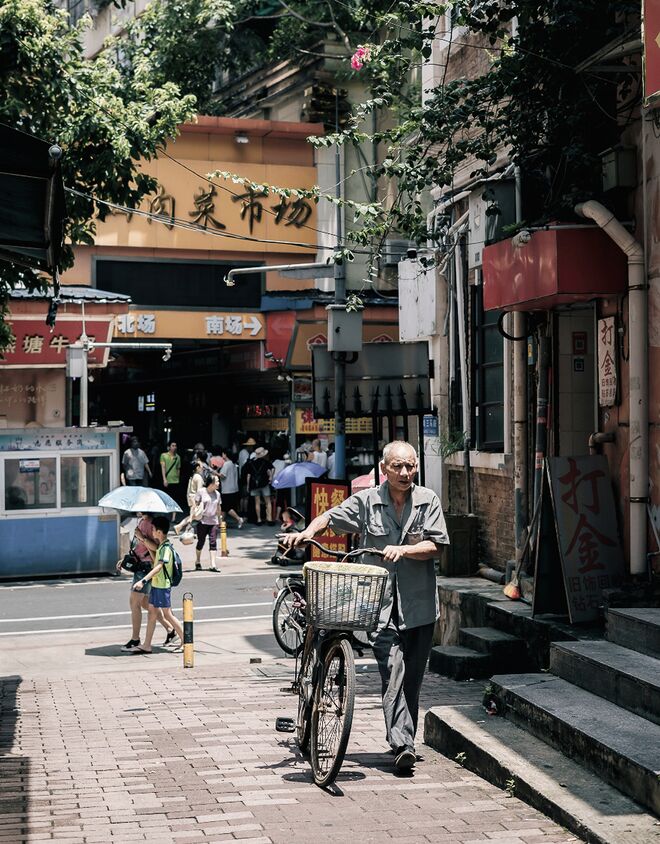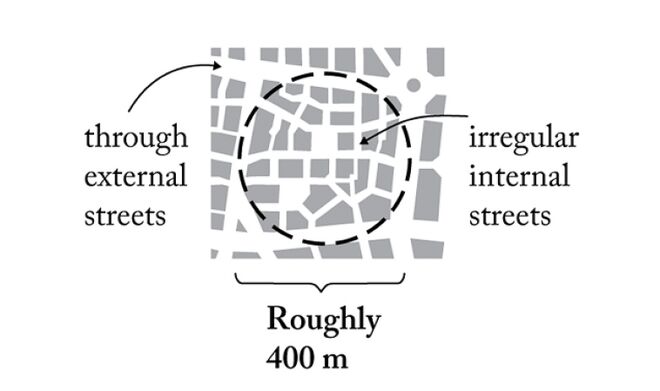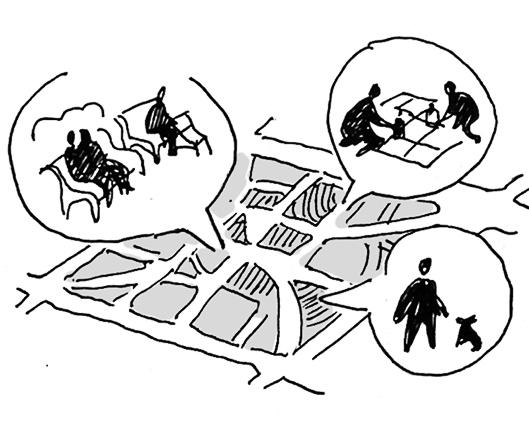4.2. Pedestrian Sanctuary
Aus Pattern Language Wiki
Within the 400M Through Street Network, identify the zones between the principal streets — roughly 400M square — and treat them differently from the areas along the streets themselves, which include Street As Center. Away from these streets, incorporate Shared Space Lane for quieter, safer spaces around residences and businesses requiring slow-low-volume traffic.
Problem-statement: Within the scale of a neighborhood, there is a need for a quieter zone where pedestrians dominate, and where vehicles are guests on their best behavior.
Discussion:: Vehicles are needed in daily life, to carry goods, to convey those who are unable to walk, to serve as transit, and for many other needs. Yet there are places in the city where vehicles are dangerous to pedestrians, especially children and the elderly.
Vehicles do have the right of way on the principal street network of the city, which provides efficient mobility while also allowing pedestrians to navigate their sides. But away from these streets, pedestrians should have greater right of way, within “sanctuaries” that provide quieter, safer spaces, including streets. Post-war urbanism confused vehicular access (allowing very slow local traffic, and delivery and emergency vehicles to enter when needed) with optimization for vehicular circulation open to anybody. Each typology has a distinct place in the city, and follows distinct design and planning rules. But the two should no longer be lumped together as a simplistic “one solution fits all”.
Therefore:
Lay out the streets within the principal through streets as slower, narrower and more irregular lanes. Do not attempt to optimize for flow, but deliberately give the priority to pedestrians through design.
Within the sanctuaries, create Neighborhood Park to provide for quieter recreation and gatherings. At the edges, create Neighborhood Square that are adjacent to more active commercial activities…
¹ The classic description of sanctuaries was developed by Donald Appleyard. See for example Appleyard, D. (1980). Livable streets: protected neighborhoods? The Annals of the American Academy of Political and Social Science, 451(1), 106-117.
Mehaffy, M. et al. (2020). PEDESTRIAN SANCTUARY (pattern). In A New Pattern Language for Growing Regions. The Dalles: Sustasis Press. Available at https://pattern-language.wiki/.../Pedestrian_Sanctuary
SECTION I:
PATTERNS OF SCALE
1. REGIONAL PATTERNS
Define the large-scale spatial organization…
1.4. 400M THROUGH STREET NETWORK
2. URBAN PATTERNS
Establish essential urban characteristics…
3. STREET PATTERNS
Identify and allocate street types…
4. NEIGHBORHOOD PATTERNS
Define neighborhood-scale elements…
5. SPECIAL USE PATTERNS
Integrate unique urban elements with care…
6. PUBLIC SPACE PATTERNS
Establish the character of the crucial public realm…
7. BLOCK AND PLOT PATTERNS
Lay out the detailed structure of property lines…
8. STREETSCAPE PATTERNS
Configure the street as a welcoming place…
9. BUILDING PATTERNS
Lay out appropriate urban buildings…
10. BUILDING EDGE PATTERNS
Create interior and exterior connectivity…
10.1. INDOOR-OUTDOOR AMBIGUITY
SECTION II:
PATTERNS OF MULTIPLE SCALE
11. GEOMETRIC PATTERNS
Build in coherent geometries at all scales…
11.2. SMALL GROUPS OF ELEMENTS
12. AFFORDANCE PATTERNS
Build in user capacity to shape the environment…
13. RETROFIT PATTERNS
Revitalize and improve existing urban assets …
14. INFORMAL GROWTH PATTERNS
Accommodate “bottom-up” urban growth…
15. CONSTRUCTION PATTERNS
Use the building process to enrich the result…
SECTION III:
PATTERNS OF PROCESS
16. IMPLEMENTATION TOOL PATTERNS
Use tools to achieve successful results…
16.2. ENTITLEMENT STREAMLINING
16.3. NEIGHBORHOOD PLANNING CENTER
17. PROJECT ECONOMICS PATTERNS
Create flows of money that support urban quality…
17.4. ECONOMIES OF PLACE AND DIFFERENTIATION
18. PLACE GOVERNANCE PATTERNS
Processes for making and managing places…
18.3. PUBLIC-PRIVATE PLACE MANAGEMENT
19. AFFORDABILITY PATTERNS
Build in affordability for all incomes…
19.1. INTEGRATED AFFORDABILITY
20. NEW TECHNOLOGY PATTERNS
Integrate new systems without damaging old ones…
20.2. RESPONSIVE TRANSPORTATION NETWORK COMPANY


